So, you’re studying for your theory test and preparing to take driving lessons—exciting times! But also: so many things to learn! Chief among them is how to interpret all the various road signs you might come across on your travels. And that's no mean feat: there are tonnes of sign designs in the UK's Highway Code. Not only do things like shape and colour affect their meaning, but different types of roads have their own unique style of sign too.
One category that you'll need to learn all about is motorway signs. Even as a learner, you might get to drive on the motorway, under the strict supervision of a qualified driving instructor. It's vital to be able to understand the signs and symbols you'll find there, because the quicker you can recognise and act on them, the safer your driving will be. As an added bonus, it will also help you pass your theory test with flying colours. So, let's delve right in—beginning with what makes motorway signs stand out from the rest.
Blue motorway signs
Most motorway-specific signs are distinguishable from signs on other roads because of their blue backgrounds. The border, writing and diagrams on them are white, so that they’re high-contrast and easy to see. The signs on motorways are bigger than on other roads, because they need to be read and understood by motorists driving at higher speeds. There are several common types of blue motorway signs in the UK.
Beginning and end of motorway signs
Before joining a motorway, you might see a ‘beginning of motorway’ sign. This has a blue background; upon it is a white design, depicting a dual carriageway running under a bridge. As you approach a motorway, you'll likely see direction signs on other roads pointing you to it. The motorway route will be highlighted in blue—or be contained within a blue panel, as it is often called.
At the end of a section of motorway, the sign is the same as at the beginning, except that there will be a red line through it. This indicates that you're joining a different type of road. You might also come across a sign reading 'End of motorway regulation' as you come off the road into a service station. That means the facilities are situated beside a motorway, but motorway rules cease to apply there.
Motorway direction signs
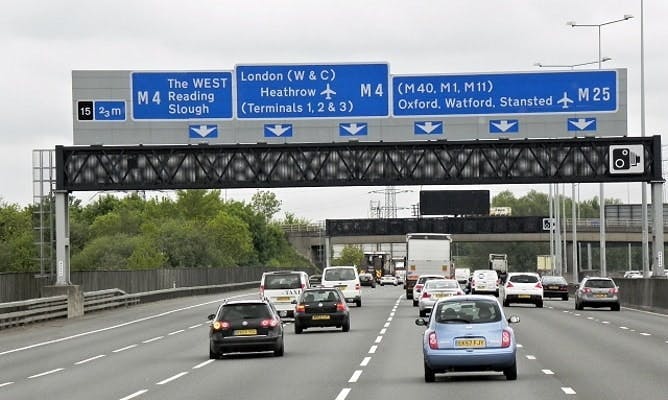
Like other direction signs in the UK, the ones on motorways are rectangular. That's because they provide information. Their job is to tell you about upcoming and imminent destinations, and give you instructions on how to get there. Most such signs are positioned by the side of the inside lane, so you will see them on the left as you're driving on the motorway.
Others are placed on gantries—bridge-like structures—above the road. These ones often tell you if you need to be in a certain lane for a specific destination. For example, if a lane is going to merge into an exit road, there would be a sign to tell drivers that the left lane is only for traffic destined for the next junction. It would direct vehicles heading to other places to move into one of the right-hand lanes. Keeping an eye on direction signs helps avoid dangerous lane-switching near junctions, and reduces the build-up of traffic around certain routes.
Motorway junction signs
At some point, you’re going to want to leave the motorway—and that’s where junctions come in. Exits are typically numbered on motorway signposts: white digits in a little black panel. The numbers are usually labelled on maps too, which makes it much easier to plan your route. All you have to do is look out for your junction number, and make sure you're in the left lane in time to take the exit road.
Most junction numbers in the UK increase or decrease consecutively. Don't take this as a hard and fast rule, though: some motorways skip junction numbers, often because there are (or were) plans to add in junctions at a later date. However, junction numbers aren't usually signed as you enter a motorway. This can be particularly confusing if you exit one motorway and switch straight onto another. After a junction, there will be a confirmatory direction sign on the side of the motorway. This is to remind you of where the road ultimately leads.
Countdown markers on motorways
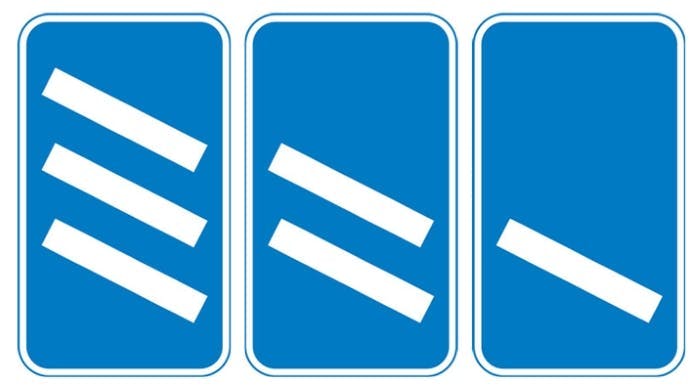
Before you get to an exit on a motorway, there are markers to count you down to it. 3 white stripes on a blue background indicate that you are 300 yards (about 275m) away from the junction. 2 stripes mean you’re 200 yards from it, and 1 stripe is your 100-yard warning. These countdown marker signs help you to know when to get in the left lane so that you can take the exit.
It takes more time to prepare for a junction on a motorway than it does on other roads. For one thing, people are usually driving quicker; for another, you might need to move across multiple lanes. If you miss your exit, you have no choice but to carry on until the next one. Sometimes getting back to where you want to go means rejoining the motorway in the opposite direction or taking smaller, slower roads back to your destination. That takes more time, fuel and stress, which can often be avoided by keeping up your observation skills.
Service station signs
Are we nearly there yet? Sometimes, you just need a break from driving. When you’re bored, tired, hungry, or have passengers who are any/all of the above, you need to find the nearest service station. Thankfully, they’re well signposted on UK motorways, in the same distinctive blue as other motorway signs.
As well as letting you know about imminent service stations, there are also signs that list the next few services along a route. This means you can make a judgement as to whether to stop at the next one, or carry on a bit further. If you make long journeys regularly, you'll soon work out your favourite stopping points. There are even national lists rating motorway services in the UK.
Driver location signs
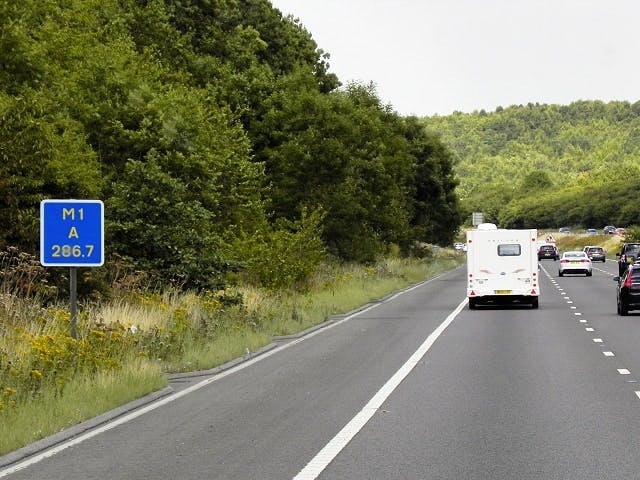
Occasionally, you might have to stop on a motorway out of necessity. Driver location signs are used to help breakdown and emergency services identify where you are. These are small blue signs with 3 lines of yellow text, positioned every 500m along motorways (and some A roads) in England.
Motorways in Scotland, Wales and Northern Ireland aren’t obliged to have them. If you break down, are involved in an incident, or see a vehicle in trouble, you can call the relevant authority and relay the information on the distance markers. The first number refers to the road you're on, and the second line will be either an A or a B, which indicates which way you're travelling. Finally, the third line tells you how far you are from a given location.
Don't worry if you forget which bit means what; even if you don’t know how to interpret it, the operator you call will be able to find you quickly using the information from the sign. Smart motorways are designed to pick up on incidents using technology like cameras, so that lanes can be closed quickly to make the road safer. Unfortunately this system is still quite limited, so it's always worth knowing about driver location signs when you're travelling on a motorway.
Top tips for finding your location
Never put yourself in danger to read a driving location sign. If you have a smartphone and data, use Street View on Google Maps to find and read your nearest marker. You can also be ultra-prepared by downloading the what3words app on your smartphone. If you share the words displayed with the emergency services, they will be able to find your exact location.
Brown motorway signs
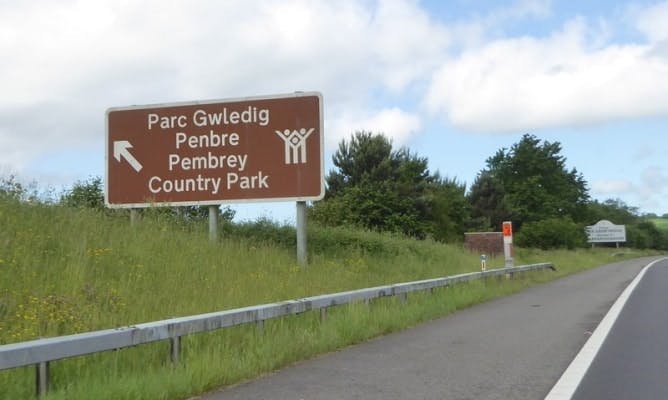
Although most motorway signs are blue, signs pointing to a place of public interest or a tourist spot have brown backgrounds instead. This keeps them consistent with tourist information signs you'll see on other roads, both in the UK and internationally.
On motorways, brown signs are used where motorists need to take an upcoming exit to arrive at an attraction. The signs often display a symbol as well as a word, to make them especially easy to read and understand. Museums, zoos, ruins and theme parks are all examples of destinations that would be displayed on brown signs.
Motorway speed limit signs
Just like on regular roads, motorways use mandatory speed limit signs to tell you the maximum speed you can travel. Permanent speed limit signs look the same as on any other road (i.e., a black number contained within a red ring). Expect to find them on gantries above the road and along the central reservation, as well as on the left-hand side. However, depending on road conditions, variable speed limits can also be used. These are temporary speed limits, and are usually positioned on gantries.
The most common motorway speed limit is expressed through the national speed limit sign. As motorways are dual carriageways, this is 70mph: the maximum speed of anywhere in the UK.
However, there are stretches of motorway where lower speed limits are enforced. Sometimes this is part of an accident reduction scheme, on a road where there have been a lot of incidents, or to protect workers where there are roadworks. Sometimes advisory speed limit signs are used on motorways. These display a number, with amber lights flashing in the corners of the sign. Although not enforceable by law, you should still take note of advisory speed limits. They reflect conditions on the road, and potential hazards that you need to be aware of.
Smart and variable motorway signs
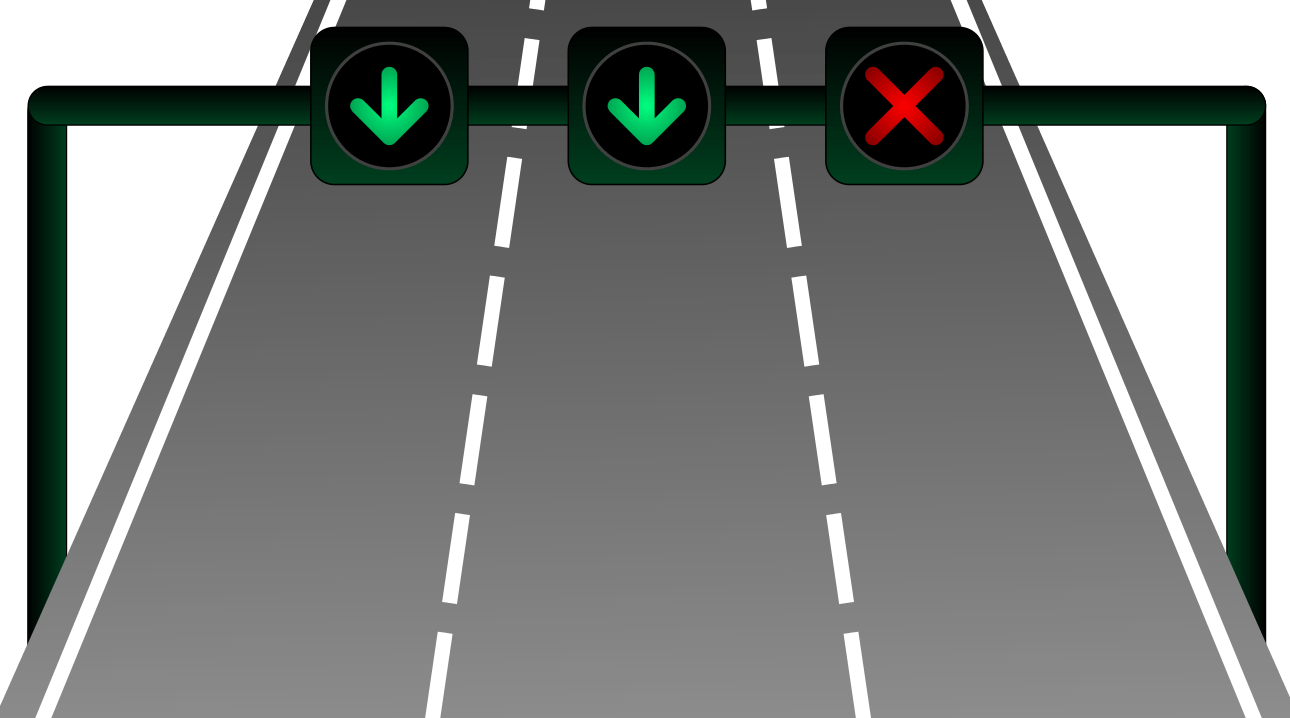
In addition to permanent signs, it's increasingly common to see temporary signs on motorways. On smart motorways, these are often placed upon gantries above your head, and have black backgrounds. Cameras and sensors help computers respond in real-time to road conditions and incidents—known as active traffic management. Relevant traffic signs are lit up as and when they're needed, in their normal colours and shapes.
For example, if a lane is closed, this is indicated with a red ‘X’ over the top of it. Or if a lower speed limit is temporarily required, the sign will display a number contained in a red ring.
Variable message signs (VMS) predate smart motorways, but are also temporary signs relating to traffic and road conditions. They are usually found on tall signposts on the left-hand side, and often contain text. VMS are used to warn motorists about upcoming hazards, such as queues, risky weather conditions like fog, or roadworks.
Subscribe for driving advice, offers & more
We'd love to let you know about our courses, news and offers via email. You may unsubscribe at any time.
Star Genie Limited trading as PassMeFast. Company number 10093359
Copyright © 2024 owned by Star Genie Limited
PassMeFast, Blue Tower, MediaCityUK, Salford, M50 2ST

